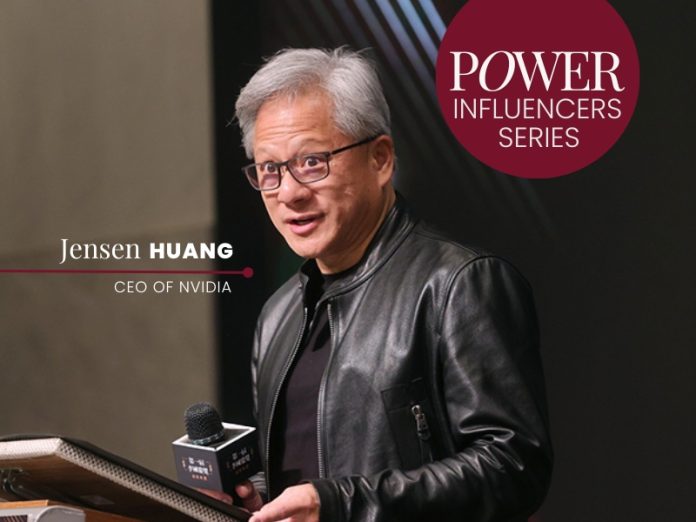By Emil Bjerg, journalist and editor
Like a nerdy Steve Jobs of the 2020s, Jensen Huang’s innovation presentations are eagerly followed by tech outlets and enthusiasts. Here we portray the charismatic CEO, equally known for his advanced AI chips and his black leather jacket, through three strategic bets that have propelled NVIDIA to the very forefront of the tech industry.
Recently Jensen Huang was in his native Taiwan for the conference COMPUTEX, where reporters talk of ‘Jensanity’ as conference visitors cheer for the NVIDIA front man. With the generative AI boom, Jensen Huang, CEO at NVIDIA, has become a tech rockstar. Or the Taylor Swift of tech, as a number of outlets has dubbed him.
Industry leaders, tech investors, and Big Tech CEOs listen closely to Huang’s presentations, where he presents everything from AI chips to supercomputers. And he has become someone tech leaders in known to rub shoulders with in the hope of securing H100 chips, NVIDIA’s most popular chip, that help companies like Meta, Amazon, Google, and Microsoft build their AI software.
Huang and NVIDIA’s chips have become an engine – and a gatekeeper – driving the AI revolution. With that, their power and market cap has gone up considerably. In the last year alone, the company’s stock has tripled, reaching a value above $3 trillion last week. In the last year, the company has surpassed Google, Amazon, and Apple, now ranking as the second most valuable company in the world. As of writing, NVIDIA is worth $3.09 billion, while Microsoft lists as $3.25 trillion. But with a much higher growth rate much higher than Microsoft’s, experts suggest NVIDIA could become the biggest company in the world shortly.
“NVIDIA has been able to catch wave upon wave of growth. Beginning with gaming demand, then crypto and now AI, they have been able to perfectly match innovation with demand and that equals explosive growth,” market analyst Brian Mulberry recently said to Reuters.
For more than 30 years Jensen Huang has been at the helm of NVIDIA – an unusually long period for a leader in a Silicon Valley tech company. With his black leather jacket, Huang might dress like a rockstar, but he’s known for his extremely high work ethic, even among his peers in Silicon Valley. “I work from the moment I wake up to the moment when I go to bed, and I work seven days a week. When I’m not working, I’m thinking about working. And when I’m working, I’m working,” he recently remarked.
To understand a man, that works all the time, let’s look into his work. Here, we portray Huang through three strategic bets, that have made him one of the most powerful people in tech and the world.
Strategic bet 1: Pioneering GPUs for video games
Huang received his master’s degree in electrical engineering from Stanford University in 1992, simoultanously getting experience working with semiconductors at LSI Logic and AMD. Working for others, Huang struggled with the lack of independence while also eying potential in a changing industry. So in early 1993 he got together with friends and fellow engineers Chris Malachowsky and Curtis Priem at a diner called Denny’s and drew down the founding ideas of NVIDIA. “Nvidia” is a portmanteau of two words, blending ‘invidia,” the Latin word for “envy,” and “NV,” which the company used as an abbreviation for “next vision”.
NVIDIA’s founding theory was that the future of computers was graphic-based: that computers would communicate through visual content like images and shapes, rather than simply text. That seems obvious today, but it was a bold and innovative idea at the time. While other semiconductor companies were moving in the same direction, Huang and his co-founders believed that a smaller, more agile company could better innovate and adapt to the rapidly changing industry. NVIDIA also decided to niche down to video games to concentrate their focus. “We smartly chose one particular combination, that was a home run. It was computer graphics and we applied it to video games” Huang recently told CNBC about their first successful strategic bet.
NVIDIA’s 1997 3D accelerator chip RIVA 128 was a commercial success, that helped establish the company as one of the main companies in computer graphics. In 1999, NVIDIA nearly went bankrupt to release what they claim to be the first official GPU, the G-force 256. But the gamble paid off: in 2000 NVIDIA became the exclusive graphics provider to Microsoft’s Xbox.
Strategic bet 2: Embracing AI and Machine Learning
The success with AI, that NVIDIA enjoys today started with the release of CUDA in 2006. CUDA, short for Compute Unified Device Architecture, is NVIDIA’s parallel computing platform that has revolutionized AI development. Simply put CUDA made it possible for regular computers to perform super complex tasks much faster than before, especially those related to AI and machine learning.
On NVIDIA’s early bet on creating platforms supporting AI development, Huang says: “We had the good wisdom to go put the whole company behind it. We saw early on, about a decade or so ago, that this way of doing software could change everything. And we changed the company from the bottom all the way to the top and sideways. Every chip that we made was focused on artificial intelligence.”
Like Huang’s belief in graphic representations on personal computers in the 90s, NVIDIA’s focus on AI seems evident today. But it wasn’t back in the 2000s. In fact, it took the market 10 years to appreciate their AI innovation: “For 10 years, Wall Street asked NVIDIA, ‘Why are you making this investment? No one’s using it.’ And they valued it at $0 in our market cap,” Bryan Catanzaro, VP of applied deep learning research at NVIDIA says. “It wasn’t until around 2016, 10 years after CUDA came out, that all of a sudden people understood this is a dramatically different way of writing computer programs,” Catanzaro said. “It has transformational speedups that then yield breakthrough results in artificial intelligence.”
Today, NVIDIA’s AI chips are used for electric vehicles, healthcare – e.g. faster drug discovery – and for generative AIs – like ChatGPT and Gemini. Huang’s bet on AI set the stage for NVIDIA’s: a diversification strategy, that has cemented their position among software developers.
Strategic bet 3: Diversification, hardware, and industry reliance
Huang and NVIDIA’s last strategic bet: creating industry reliance through a number of projects and products, that support NVIDIA’s main activity: selling chips and other types of hardware. NVIDIA has become a company that also produces computers, software, cloud services, trained A.I. models, and processors. NVIDIA’s comprehensive offerings create an ecosystem where clients become reliant on multiple NVIDIA products and services. That makes it difficult for competitors to displace NVIDIA, as switching would require a complete overhaul of a company’s tech stack.
“NVIDIA works very well with the software community. This is not a chip business. This is a business of figuring out things end-to-end,” as semi-conductor analyst Vivek Arya says. This gives them a clear advantage over their competitors. As tech entrepreneur Naveen Rao recently told The New York Times: “Everybody builds on NVIDIA first. If you come out with a new piece of hardware, you’re racing to catch up.”
The diversification strategy also has a practical advantage: multiple revenue streams beyond one-time chip sales. Software subscriptions, cloud services fees, and ongoing support for AI models provide a steady income, making NVIDIA’s financial performance more resilient.
The “NVIDIA first” mentality among tech companies cements the company’s dominance. Today NVIDIA is Big Tech’s biggest supplier. Their popular H100 chips are sold in the tens of thousands to companies like Meta and Microsoft – each chip sold for around $25,000 each.
Leading the second biggest company in the world, Jensen – and NVIDIA shareholders – will likely have one main worry: US-China relations.
Taiwanese tensions
Jensen, as a Taiwanese-American, has a high personal and professional investment in the safety of Taiwan. With the vast majority of NVIDIA’s chips being produced at Taiwan Semiconductor Manufacturing Company, the escalating tensions between the U.S. and China pose a direct threat to the company’s supply chain and general operations. The ongoing trade war has already impacted Nvidia, forcing them to navigate export restrictions and explore alternative manufacturing options to mitigate risks. But the establishment of new semiconductor manufacturing facilities requires massive capital investments, specialized expertise, and intricate supply chains. Continued peace in Taiwan is a much more desired situation than the alternative.
Speaking of Taiwan, here Jensen Huang “is literally being treated like a rock star,” technology analyst Bob O’Donnell reports to BBC. “Jensen sees this opportunity to build on Nvidia.” Jensen Huang’s next bet? Perhaps using his rockstar status to take NVIDIA even further.




































































